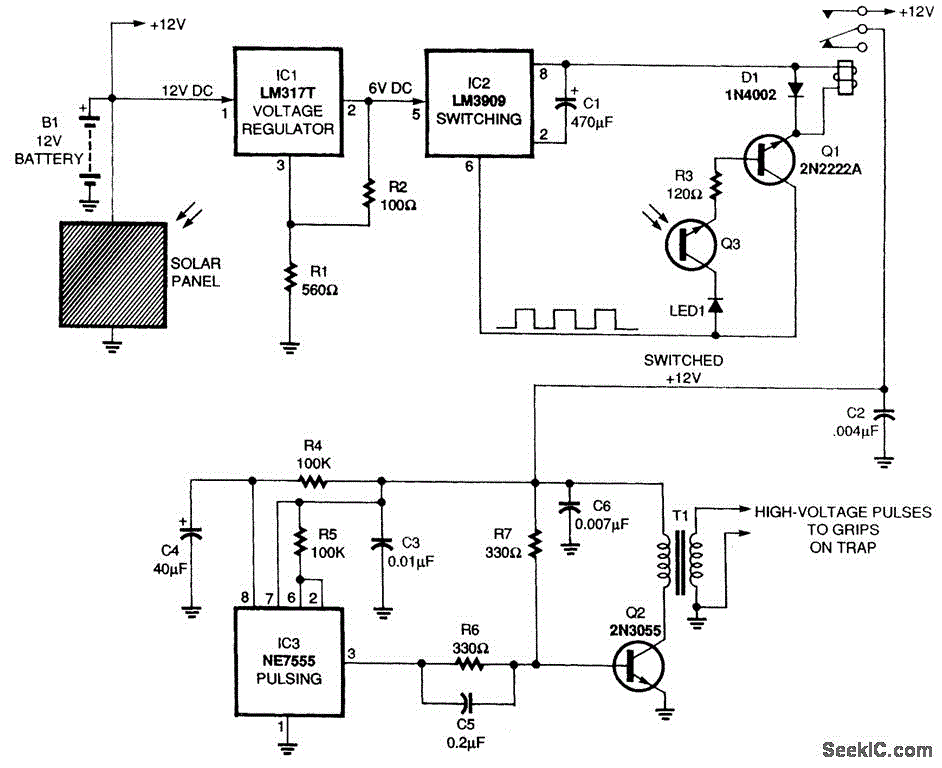
SOLAR_POWERED_INSECT_CONTROLLER

The circuit for the solar-powered controller includes a switching circuit, a pulsing circuit, and a high-voltage output circuit. The external power components consist of a 1- to 5-W solar panel and a 12-V motorcycle or camcorder battery. The output from the high-voltage ignition coil connects to a network of paralleled electrodes, referred to as a grid.
The solar-powered controller circuit is designed to efficiently harness solar energy for various applications, particularly in igniting or energizing systems requiring high voltage. The core components of the circuit include a switching circuit that regulates the flow of energy, a pulsing circuit that generates high-frequency signals, and a high-voltage output circuit that transforms the low voltage received from the solar panel and battery into a higher voltage suitable for the ignition coil.
The switching circuit typically employs a transistor or MOSFET to control the power from the solar panel and battery. This component is crucial for ensuring that energy is delivered at the right time and in the correct amount to the pulsing circuit. The pulsing circuit, often utilizing a combination of resistors, capacitors, and inductors, creates a series of rapid on-off pulses that are necessary for the ignition process. This pulsing action is essential for building up the energy required to generate a high-voltage output.
The high-voltage output circuit is connected to an ignition coil, which is responsible for stepping up the voltage to a level sufficient for ignition. The output from the ignition coil is then directed to a grid of paralleled electrodes. This grid configuration allows for the distribution of the high-voltage output across multiple points, enhancing the efficiency of the ignition process or the intended application.
The choice of a 1- to 5-W solar panel ensures that the circuit remains energy-efficient, while the 12-V battery serves as a reliable backup power source, facilitating operation even during low sunlight conditions. This combination of renewable energy and battery backup allows for sustainable operation in various environments. Overall, the design of the solar-powered controller circuit exemplifies an effective integration of renewable energy technology with high-voltage applications.The circuit for the solar-powered controller consists of a switching circuit, a pulsing circuit, and a high-voltage output circuit. The external power components are a 1- to 5-W solar panel and a 12-V motorcycle or camcorder battery.
The output of the high-voltage ignition coil connects to a net-work of paralleled electrodes, called a grid, upon which flie.. 🔗 External reference
The solar-powered controller circuit is designed to efficiently harness solar energy for various applications, particularly in igniting or energizing systems requiring high voltage. The core components of the circuit include a switching circuit that regulates the flow of energy, a pulsing circuit that generates high-frequency signals, and a high-voltage output circuit that transforms the low voltage received from the solar panel and battery into a higher voltage suitable for the ignition coil.
The switching circuit typically employs a transistor or MOSFET to control the power from the solar panel and battery. This component is crucial for ensuring that energy is delivered at the right time and in the correct amount to the pulsing circuit. The pulsing circuit, often utilizing a combination of resistors, capacitors, and inductors, creates a series of rapid on-off pulses that are necessary for the ignition process. This pulsing action is essential for building up the energy required to generate a high-voltage output.
The high-voltage output circuit is connected to an ignition coil, which is responsible for stepping up the voltage to a level sufficient for ignition. The output from the ignition coil is then directed to a grid of paralleled electrodes. This grid configuration allows for the distribution of the high-voltage output across multiple points, enhancing the efficiency of the ignition process or the intended application.
The choice of a 1- to 5-W solar panel ensures that the circuit remains energy-efficient, while the 12-V battery serves as a reliable backup power source, facilitating operation even during low sunlight conditions. This combination of renewable energy and battery backup allows for sustainable operation in various environments. Overall, the design of the solar-powered controller circuit exemplifies an effective integration of renewable energy technology with high-voltage applications.The circuit for the solar-powered controller consists of a switching circuit, a pulsing circuit, and a high-voltage output circuit. The external power components are a 1- to 5-W solar panel and a 12-V motorcycle or camcorder battery.
The output of the high-voltage ignition coil connects to a net-work of paralleled electrodes, called a grid, upon which flie.. 🔗 External reference